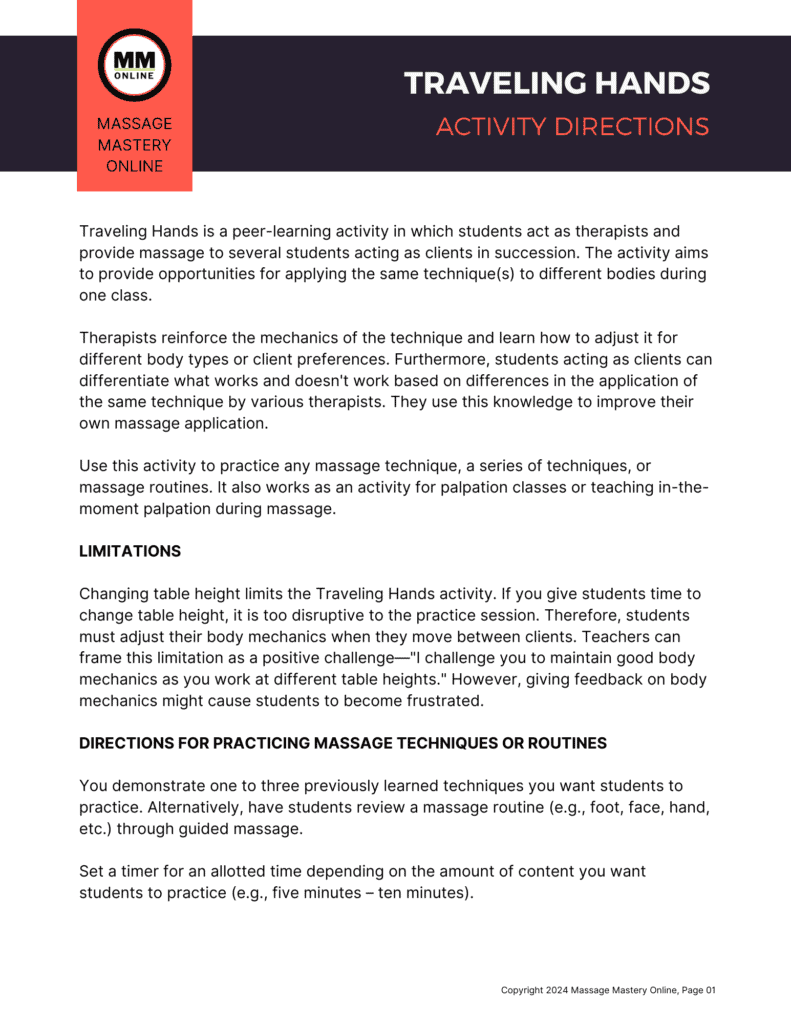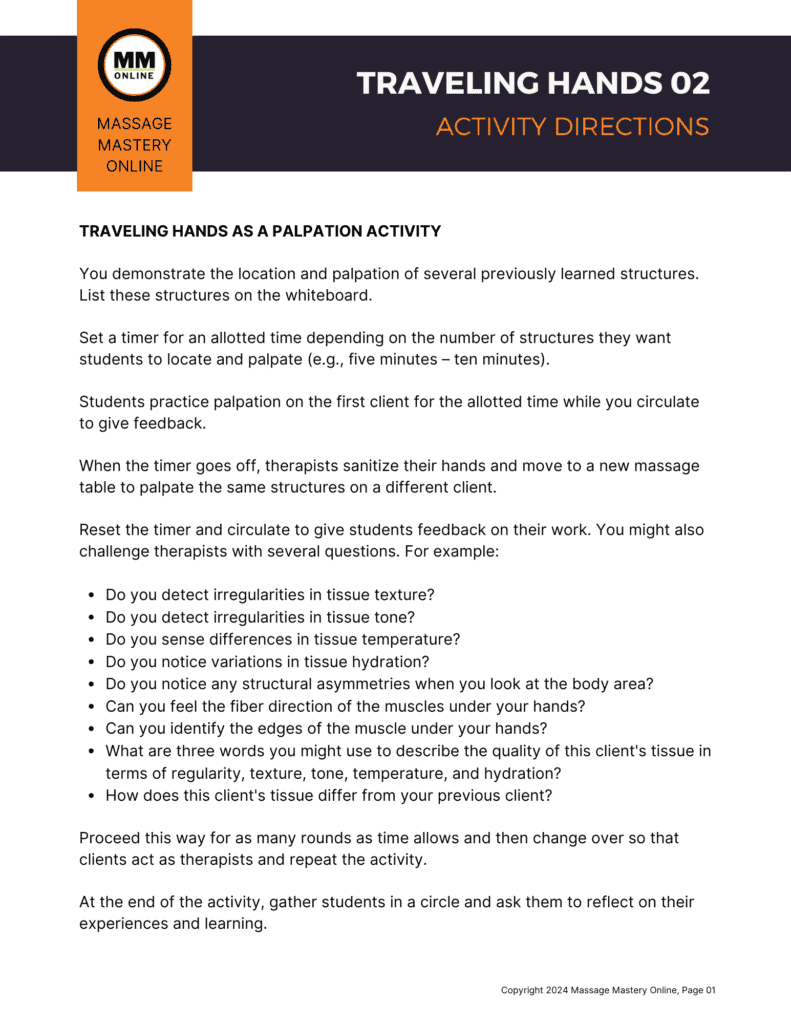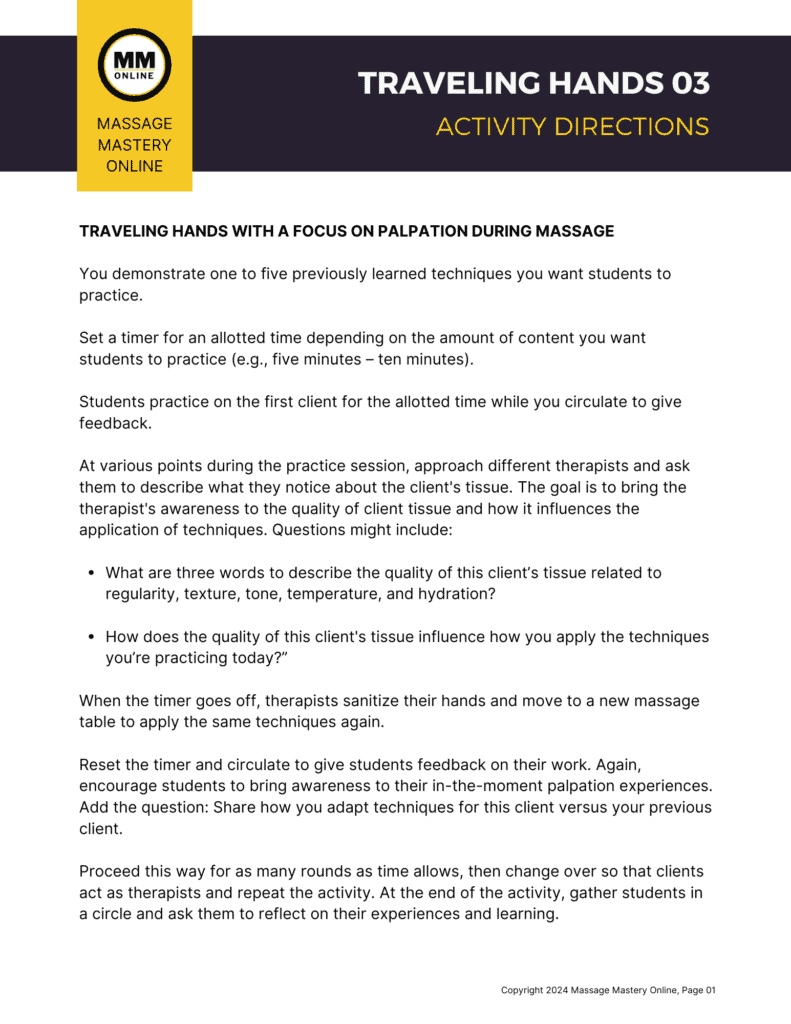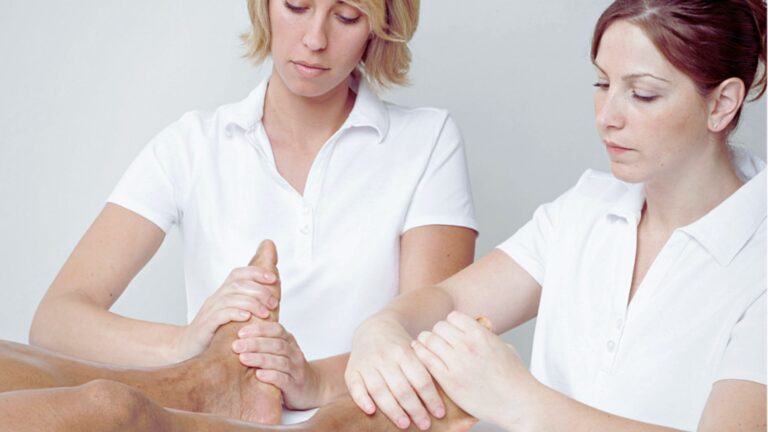The Traveling Hands Activity for Massage students
Introduction
Traveling Hands is a peer-learning activity in which students act as therapists and provide a massage to several students acting as clients in succession. The activity aims to provide opportunities for applying the same technique(s) to different bodies within a single class.
Therapists reinforce the mechanics of the technique and learn how to adjust it for different body types or client preferences. Furthermore, students acting as clients can differentiate what works and doesn’t work based on differences in the application of the same technique by various therapists. They use this knowledge to improve their own massage application.
Use this activity to practice any massage technique, a series of techniques, or massage routines. It also works as an activity for palpation classes or teaching in-the-moment palpation during massage. You can download the directions to keep with your teaching materials at the bottom of the article.
Limitations
Changing the table height limits the Traveling Hands activity. If you give students time to change the table height, it is too disruptive to the practice session. Therefore, students must adjust their body mechanics when they move between clients. Teachers can frame this limitation as a positive challenge—”I challenge you to maintain good body mechanics as you work at different table heights.” However, giving feedback on body mechanics might cause students to become frustrated.
General Directions for Practicing Massage Techniques or Routines
- You demonstrate one to three previously learned techniques you want students to practice. Alternatively, have students review a massage routine (e.g., foot, face, hand, etc.) through guided massage.
- Set a timer for an allotted time, depending on the amount of content you want students to practice (e.g., 5 minutes – 10 minutes).
- Students practice on the first client for the allotted time while you circulate to give feedback.
- When the timer goes off, therapists sanitize their hands, move to a new massage table, and apply the same techniques to a new client.
- Reset the timer and circulate to give students feedback on their work.
- Proceed this way for as many rounds as time allows, then change over so that clients act as therapists and repeat the activity.
- At the end of the activity, gather students in a circle and ask them to reflect on their experiences. Ask them to share their challenges and learning.
Traveling Hands as a Palpation Activity
- You demonstrate the location and palpation of several previously learned structures. List these structures on the whiteboard.
- Set a timer for an allotted time, depending on the number of structures students are expected to locate and palpate (e.g., 5 minutes – 10 minutes).
- Students practice palpation on the first client for the allotted time while you circulate to give feedback.
- When the timer goes off, therapists sanitize their hands and move to a new massage table to palpate the same structures on a different client.
- Reset the timer and circulate to give students feedback on their work. You might also challenge therapists with several questions. For example:
- Do you detect irregularities in tissue texture?
- Do you detect irregularities in tissue tone?
- Do you sense differences in tissue temperature?
- Do you notice variations in tissue hydration?
- Do you notice any structural asymmetries when you look at the body area?
- Can you feel the fiber direction of the muscles under your hands?
- Can you identify the edges of the muscle under your hands?
- What are three words you might use to describe the quality of this client’s tissue in terms of regularity, texture, tone, temperature, and hydration?
- How does this client’s tissue differ from your previous client?
- Proceed this way for as many rounds as time allows, and then change over so that clients act as therapists and repeat the activity.
- At the end of the activity, gather students in a circle and ask them to reflect on their experiences and learning.
Traveling Hands with a Focus on Palpation During Massage
- You demonstrate one to five previously learned techniques you want students to practice.
- Set a timer for an allotted time, depending on the amount of content you want students to practice (e.g., 5 minutes – 10 minutes).
- Students practice on the first client for the allotted time while you circulate to give feedback.
- At various points during the practice session, approach different therapists and ask them to describe what they notice about the client’s tissue. The goal is to bring the therapist’s awareness to the quality of client tissue and how it influences the application of techniques. Questions might include:
- What are three words to describe the quality of this client’s tissue related to regularity, texture, tone, temperature, and hydration?
- How does the quality of this client’s tissue influence how you apply the techniques you’re practicing today?”
- When the timer goes off, therapists sanitize their hands and move to a new massage table to apply the same techniques again.
- Reset the timer and circulate to give students feedback on their work. Again, encourage students to bring awareness to their in-the-moment palpation experiences. Questions might include:
- What are three words to describe the quality of this client’s tissue related to regularity, texture, tone, temperature, and hydration?
- How does the quality of this client’s tissue influence how you apply the techniques you’re practicing today?”
- Share how you adapt techniques for this client versus your previous client.
- Proceed this way for as many rounds as time allows, then change over so that clients act as therapists and repeat the activity.
- At the end of the activity, gather students in a circle and ask them to reflect on their experiences and learning.





